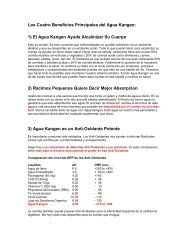ACID-ALKALINE BALANCE: ROLE IN CHRONIC ... - My Kangen Tools
ACID-ALKALINE BALANCE: ROLE IN CHRONIC ... - My Kangen Tools
ACID-ALKALINE BALANCE: ROLE IN CHRONIC ... - My Kangen Tools
You also want an ePaper? Increase the reach of your titles
YUMPU automatically turns print PDFs into web optimized ePapers that Google loves.
Tanner and Tanner: Citrate treatment in PKD rats 1861<br />
perchloric acid. The samples were centrifuged, and the<br />
supernatants were then filtered through a 10,000 molecular<br />
weight cutoff UltraFuge filter (Micron Separations,<br />
Westboro, MA, USA).<br />
Histology<br />
The remaining kidney was fixed by retrograde aortic<br />
perfusion with a solution of 3% paraformaldehyde, 137<br />
mmol/L NaCl, 2.7 mmol/L KCl, 1.5 mmol/L KH 2 PO 4 , 4<br />
mmol/L Na 2 HPO 4 , and 2 mmol/L picric acid . at a perfusion<br />
pressure of 150 to 170 mm Hg. The kidney was<br />
kept in the same fixative solution for several days in the<br />
refrigerator and then weighed, sliced with a razor blade,<br />
immersed in 0.1 mol/L cacodylate solution (pH 7.25),<br />
and embedded in paraffin. Sections were stained with<br />
hematoxylin and eosin. The degree of cystic disease (size<br />
of cysts, interstitial widening and fibrosis, presence of<br />
inflammatory cells) was evaluated blindly using an arbitrary<br />
scale of 0 to 4, where 0 represents the normal<br />
condition and 4 represents severe changes.<br />
Chemical analyses<br />
Polyfructosan (a synthetic inulin) in plasma and urine<br />
was determined by an anthrone method [12]. PAH was<br />
determined by Bratton and Marshall’s method [13]. Ci-<br />
trate in plasma, urine, and tissue samples was determined<br />
spectrophotometrically using a citrate lyase method<br />
(Boehringer Mannheim, Indianapolis, <strong>IN</strong>, USA). Recovery<br />
of citrate added to plasma averaged 99 6% (N <br />
11). When kidney tissue was analyzed for citrate, we<br />
observed a 100 5% (N 25) recovery of an internal<br />
citrate standard at five minutes after adding the citrate<br />
lyase, indicating completion of the reaction. The absor-<br />
bance readings, however, continued to drift appreciably<br />
with time, probably because of the presence of nicotin-<br />
amide adenine dinucleotide (NADH) oxidase activity in<br />
kidney cortex extracts. To correct for this “creep,” we<br />
measured absorbance every 5 minutes for a total of 20<br />
minutes after adding the citrate lyase and extrapolated<br />
the absorbance back to time zero [14]. Ammonia was<br />
determined using a glutamate dehydrogenase-based kit<br />
(Boehringer Mannheim). Recovery of ammonia added<br />
to plasma averaged 100 1.4% (N 4). Phosphate in<br />
plasma was determined by the Fiske-SubbaRow method.<br />
Potassium in urine and plasma and calcium in plasma,<br />
urine, and kidney tissue were determined using an atomic<br />
absorption spectrophotometer (model 951; Instrumenta-<br />
tion Laboratory, Wilmington, MA, USA). Tissue sam-<br />
ples were homogenized in a solution containing 4% (vol/<br />
vol) butanol, 0.2 mol/L HCl, and 36 mmol/L LaCl 3 [15]<br />
using a Polytron homogenizer (Brinkmann Instruments,<br />
Westbury, NY, USA). Recovery of calcium added to<br />
tissue samples averaged 103 3% (N 9). Samples<br />
and standards were always prepared in the same matrix<br />
solutions.<br />
Calculations<br />
The GFR was calculated from the rate of excretion<br />
of polyfructosan divided by the plasma polyfructosan<br />
concentration. Renal plasma flow (RPF) was calculated<br />
from the PAH clearance divided by the PAH extraction<br />
ratio ((arterial minus renal venous plasma [PAH]) <br />
arterial plasma [PAH]). Renal blood flow (RBF) was<br />
calculated from this formula: RBF RPF/(1 hemato-<br />
crit). Renal citrate consumption was calculated from<br />
RPF (arterial plasma [citrate] renal vein plasma<br />
[citrate]) minus urinary citrate excretion rate. Tubular<br />
reabsorption was calculated from the filtered load minus<br />
the excretion rate. Peritubular uptake of citrate was cal-<br />
culated from the renal citrate consumption minus the<br />
rate of tubular citrate reabsorption. Fractional excretion<br />
was calculated from the excretion rate divided by the<br />
filtered load. Renal ammonia production was calculated<br />
from the RBF (renal venous blood [ammonia] arte-<br />
rial blood [ammonia]) plus the urinary excretion rate.<br />
The partial pressure of cortical tissue ammonia (P NH3 )<br />
was estimated from the renal vein total NH 4 concentration<br />
and arterial blood pH [16, 17] and this formula:<br />
P NH3 (total NH 4 22.09)/(10 pK pH )<br />
where the pK for NH 4 is 9.02. The pH of renal venous<br />
and arterial blood are assumed to be the same, and the<br />
solubility coefficient () for ammonia is 0.91 [18].<br />
Statistical methods<br />
Data presented are means SD. They were analyzed<br />
by two-way analysis of variance (ANOVA), after a pre-<br />
liminary test for homogeneity of variances. Individual<br />
groups were compared with the Bonferroni method. If<br />
variances were heterogeneous, the Kruskal–Wallis test<br />
and Dunn’s test were used to compare means. A P value<br />
of less than 0.05 was considered significant.<br />
RESULTS<br />
Overall function in six-month-old rats<br />
The effects of KCitr consumption in six-month-old<br />
normal rats and rats with PKD are summarized in Table<br />
1. The most remarkable finding is that GFR was com-<br />
pletely normal in rats with PKD that had been treated<br />
with KCitr, whereas GFR was only 37% of normal in<br />
rats with PKD that had consumed tap water. RBF also<br />
was normal in the rats with PKD that had been treated<br />
with KCitr and was about half of normal in untreated<br />
rats with PKD. KCitr treatment had no effect on body<br />
weight or blood pressure, in agreement with our earlier<br />
findings at three months of age [7].<br />
A comparison of water-drinking normal rats and wa-<br />
ter-drinking rats with PKD (Table 1) shows that the<br />
animals with cystic disease had heavier kidneys, higher



